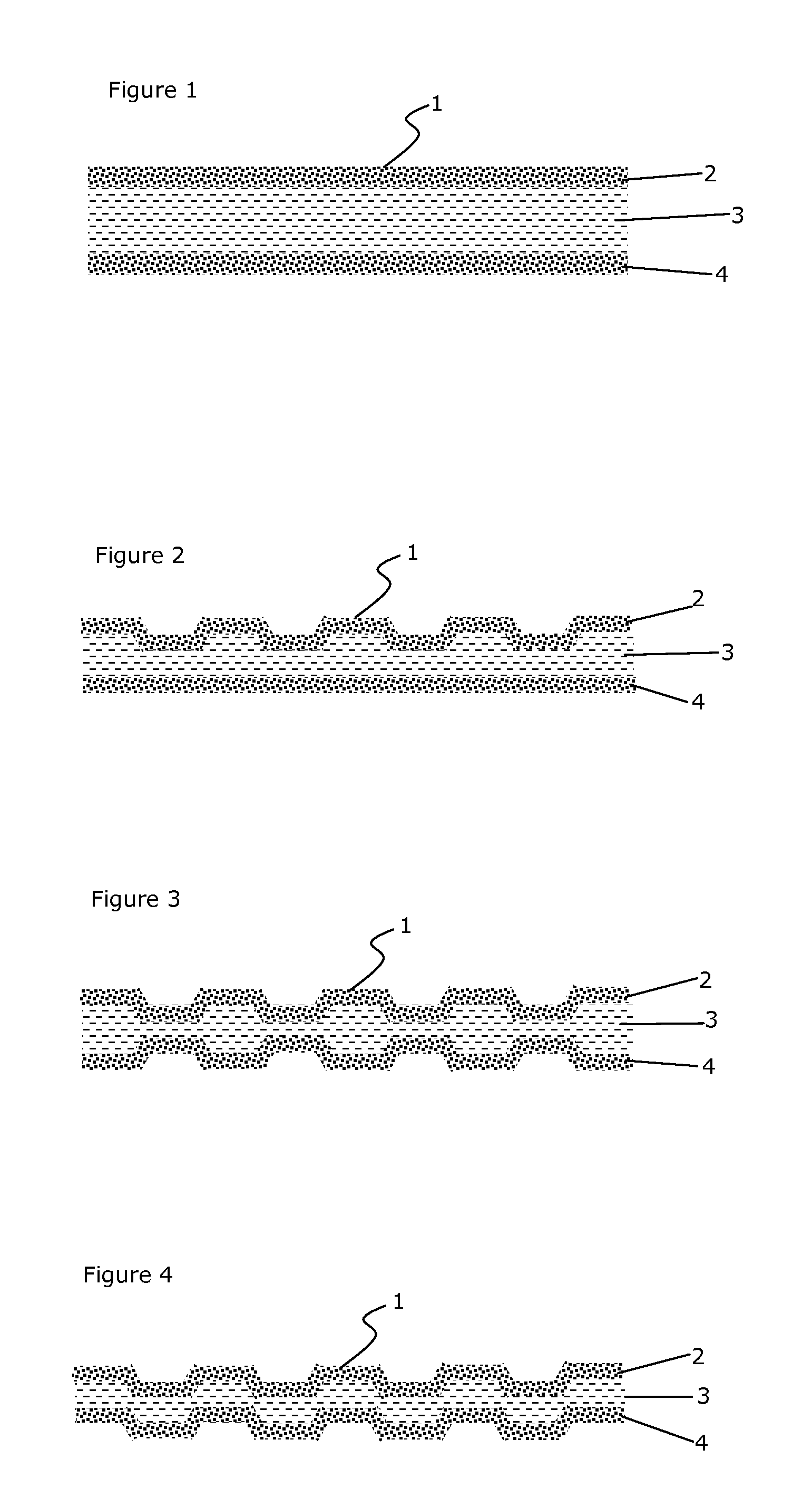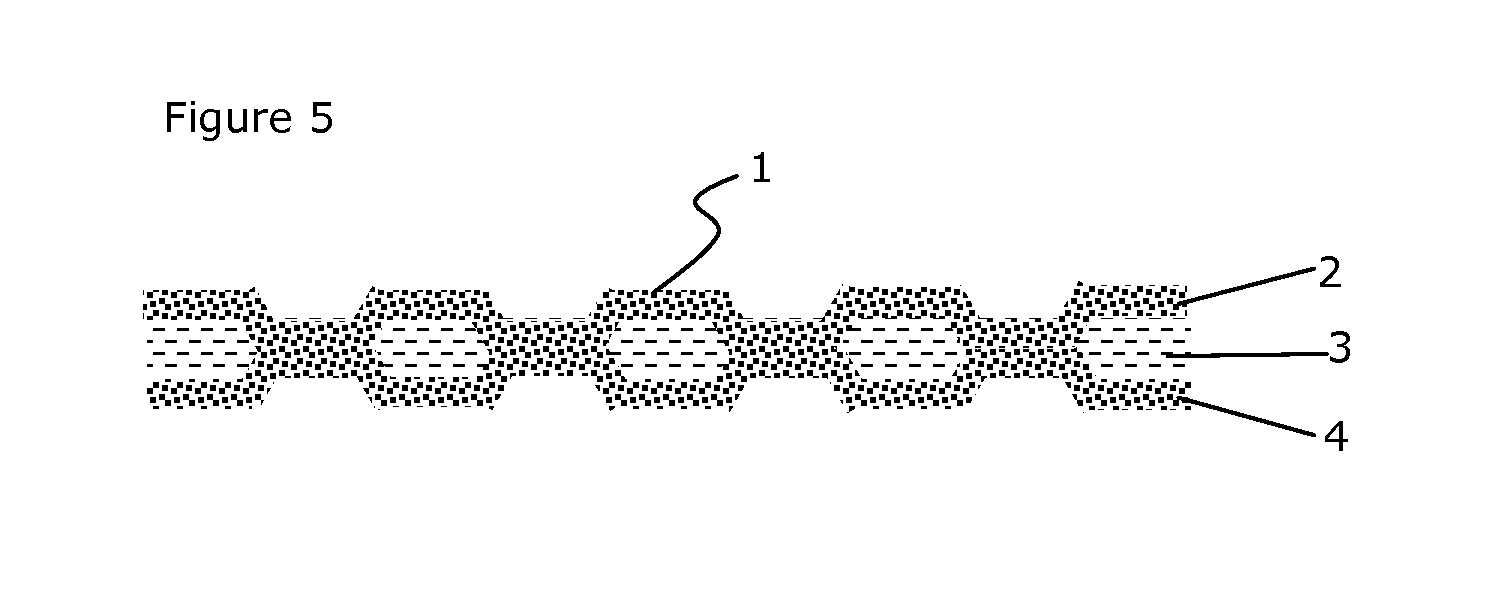High cellulose content, laminiferous nonwoven fabric
a laminiferous non-woven fabric, high cellulose content technology, applied in the direction of cellulosic plastic layered products, cleaning equipments, other domestic articles, etc., can solve the problems of shedding pulp fibres, affecting the durability of wipes, and undesirable effects of non-woven fabrics made entirely of pulp fibres
- Summary
- Abstract
- Description
- Claims
- Application Information
AI Technical Summary
Benefits of technology
Problems solved by technology
Method used
Image
Examples
examples
[0153]In the description above and in the non-limiting Examples that follow, the following test methods were employed to determine various reported characteristics and properties. ASTM refers to the American Society for Testing and materials, INDA refers to the Association of the Nonwovens Fabrics Industry, and IEST refers to the Institute of Environmental Sciences and Technology.
[0154]Testing was generally carried out in accordance with the test methods recommended by INDA; any deviation from an INDA test method is noted in the text. Prior to the testing of dry properties, the samples were conditioned for 24 hours in a controlled environment at about 20° C., and 50% relative humidity, unless specified otherwise.
[0155]Basis weight (in grams per square meter, or gsm) was measured by a test method that generally follows the INDA test method IST 130.1 (1998). Samples were die cut to 8 inches by 8 inches (20.3 cm by 20.3 cm), and weighed in grams to four decimal places on a digital bala...
examples 1-3
[0184]Examples 1 to 3 illustrate the manufacture and properties of 3-ply laminates with a high woodpulp content, together with other desirable properties. The composition and properties of these Examples is summarised in Table E.
[0185]In Examples 1-2, the two outer layers were taken from a roll of polypropylene high strength meltblown web of about 5 gsm basis weight, prepared as described above from Basell Profax grade PH835 polypropylene resin. In Example 3, the two outer layers were taken from a roll of polypropylene high strength meltblown web of about 8 gsm basis weight, prepared as described above from Basell Profax grade PH835 polypropylene resin. The meltblown filaments were topically treated in the manner described above with an aqueous solution of Cytec Aerosol GPG surfactant. The concentration of the solution was adjusted to give a surfactant add on of about 1% by weight.
[0186]The middle layer of the laminate was an airlaid web of about 45 gsm basis weight, and comprised o...
examples 4 and 5
[0190]Examples 4 and 5 illustrate the manufacture and properties of 3-ply laminates made using a wetlaid middle layer. The composition and properties of these Examples, together with Example 1 as a comparison, is shown in Table F. Examples 4 and 5 contained about 65% or more woodpulp.
[0191]
TABLE FHIGH STRENGTH MELTBLOWN / AIRLAID orWETLAID WEB / HIGH STRENGTH MELTBLOWNEx. 1Ex. 4Ex. 5Nominal Construction (gsm)5 / 45 / 55 / 45 / 55 / 45 / 5Middle layer pulp forming method, pulp typeairlaid, fluffwetlaid, fluffwetlaid, kraftpulppulppulpBinder fibre content of airlaid web, %, type20% PE:PET20% PE:PET10% PP mono-bicomponentbicomponentcomponentNominal Woodpulp Content, %65.565.573.6Basis Weight, (gsm)59.555.453.4Dry Tensile Strength, MD (N / m)3575651235Wet Tensile Strength, MD (N / m)300232183Wet Tensile Strength, CD (N / m)16512697Wet T.S. geometric mean (N / m)222171133Wet Toughness, MD (J)0.1320.0640.099Wet Toughness, CD (J)0.0800.0600.116Wet Elmendorf Tear Strength, MD (mN)1,1201,120600Dry Thickness (micron...
PUM
| Property | Measurement | Unit |
|---|---|---|
| length | aaaaa | aaaaa |
| length | aaaaa | aaaaa |
| lengths | aaaaa | aaaaa |
Abstract
Description
Claims
Application Information
 Login to View More
Login to View More - R&D
- Intellectual Property
- Life Sciences
- Materials
- Tech Scout
- Unparalleled Data Quality
- Higher Quality Content
- 60% Fewer Hallucinations
Browse by: Latest US Patents, China's latest patents, Technical Efficacy Thesaurus, Application Domain, Technology Topic, Popular Technical Reports.
© 2025 PatSnap. All rights reserved.Legal|Privacy policy|Modern Slavery Act Transparency Statement|Sitemap|About US| Contact US: help@patsnap.com



